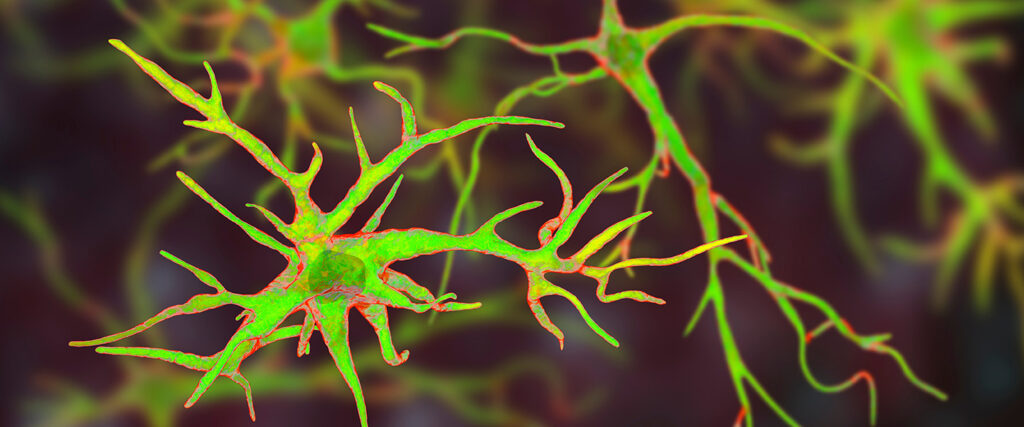Research that was initially focused on fear, anxiety, and defensive behaviors has resulted in a series of unexpected discoveries that have shed new light on eating behaviors, and, possibly, on eating disorders involving both compulsive eating when already “full” as well as aversion to food even when hungry.
In a paper newly appearing in Nature Communications, a team led by 2014 BBRF Young Investigator Avishek Adhikari, Ph.D., of UCLA, reports that it has identified a brain circuit in mice whose activation causes the animals to search for food even when they are not hungry. By manipulating the circuit, the researchers demonstrated they could increase or decrease food-seeking in mice, a discovery that might have translational potential in people with eating disorders since the circuit, or one very similar to it, likely also exists in the human brain.
The paper’s first author, who designed and performed many of the experiments just reported, was Fernando M. C. V. Reis, Ph.D., also of UCLA. His 2018 BBRF Young Investigator award helped support research that was originally focused on fear memory. A second Young Investigator grant in 2022 funded work that enabled Dr. Reis and colleagues to pursue unexpected discoveries pertaining not just to fear and defensive behaviors but to the brain’s food-seeking circuitry as well.
The investigators were studying an area in the brain called the periaqueductal grey, or PAG. This region was known to have an important role in fear, but not in the pursuit of food. The team was initially investigating how cells in the PAG that release the neurotransmitter GABA (called VGAT-expressing neurons) affect fear. In the course of their experiments, the team was surprised to discover that these VGAT-expressing neurons can dramatically alter feeding—their activation led the animals to forage for food and to eat on a full stomach.
The PAG is located in the brainstem, notes Dr. Adhikari, “which is very old in evolutionary history, and because of that, it’s functionally similar between humans and mice.” While acknowledging the team’s findings were a surprise, he said it did “make sense that foraging is rooted in such an ancient part of the brain, since foraging is something all animals must do.”
Dr. Adhikari received his graduate and postdoctoral training in the labs of two past BBRF grantees, both of whom are members of BBRF’s Scientific Council: Joshua Gordon, M.D., Ph.D., who is director of the National Institute of Mental Health, and Karl Deisseroth, M.D., Ph.D., who in 2021 received the Lasker Basic Medical Research Award for his role in developing optogenetics technology.
Dr. Adhikari’s studies initially focused on how fear and anxiety help animals assess risks and minimize exposure to threats. The PAG is particularly associated with the panic response, in rodents and people. “When we used optogenetics to selectively simulate only this specific group of VGAT-expressing GABA neurons in the PAG, we found it did not affect the animals’ fear responses; rather, it caused them to forage and eat,” he notes.
The team further observed that when these cells were stimulated, mice that were not hungry started to specifically crave fatty food—so much that they were willing to endure mild electrical shocks to their feet in order to obtain this food. (The harmless but unpleasant shocks are like those one gets when experiencing static electricity.) Stimulation of the cells was not, in other words, inducing feeding by creating hunger, which is an unpleasant feeling; rather, activation was associated with pleasure and reward.
Conversely, when the researchers experimentally suppressed the activity of the same cells in the PAG, mice that were very hungry ate significantly less. This shows, says Dr. Reis, that “this circuit can bypass normal hunger pressures regarding how, what, and when to eat.”
This suggests the potential relevance of the results to eating disorders in people. It is almost certain that humans also have VGAT cells in the PAG, as these neurons have been confirmed in a wide range of animals, including rodents, cats, and monkeys.
If additional research confirms that humans also have VGAT-expressing cells in the PAG, researchers can then try to determine if overactivity in the circuit is correlated with the feeling of reward and with craving high-calorie food even when an individual is not hungry. It is also conceivable that if underactive, the same circuit might also help explain reduced pleasure associated with eating, perhaps leading in some people to the avoidance of food. Compulsive eating when not hungry is a behavior seen in binge eating disorder. Avoiding nutrition even when deprived of calories is seen in anorexia nervosa.
In the near-term, there is much more basic research to do. In their paper, the team suggests the need to investigate, for instance, how connections between the VGAT-expressing cells in the PAG and cells in a brain area called the zona incerta may regulate important aspects of the motivation to forage and eat. Circuits controlling appetite and eating behaviors, they say, can perhaps “be viewed as a broad complex loop network” whose distinct functional and computational components “require further characterization.”
The team also included Jonathan C. Kao, Ph.D., a 2020 BBRF Young Investigator; and Alcino J. Silva, Ph.D., a 1999 BBRF Independent Investigator.

